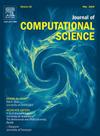State, parameters and hidden dynamics estimation with the Deep Kalman Filter: Regularization strategies
IF 3.7
3区 计算机科学
Q2 COMPUTER SCIENCE, INTERDISCIPLINARY APPLICATIONS
引用次数: 0
Abstract
In this paper we present in detail the various regularization strategies adopted for a novel scientific machine learning extension of the well known Kalman Filter (KF) that we call the Deep Kalman Filter (DKF), briefly presented in the conference paper (Chinellato and Marcuzzi 2024) . It is based on a recent scientific machine learning paradigm, called algorithm unfolding/unrolling, that allows to create a neural network from the algebraic structure dictated by an analytical method of scientific computing. We show the interpretable consistency of DKF with the classic KF when this is optimal, and its improvements against the KF with both linear and nonlinear models in general. Indeed, the DKF learns parameters of a quite general reference model, comprising: corrector gains, predictor model parameters and eventual unmodeled dynamics. This goes well beyond the ability of the KF and its known extensions.
状态、参数和隐动态估计与深度卡尔曼滤波:正则化策略
在本文中,我们详细介绍了用于众所周知的卡尔曼滤波器(KF)的新型科学机器学习扩展所采用的各种正则化策略,我们称之为深度卡尔曼滤波器(DKF),简要介绍了会议论文(Chinellato和Marcuzzi 2024)。它基于一种最新的科学机器学习范式,称为算法展开/展开,它允许从科学计算的分析方法所规定的代数结构中创建神经网络。在最优情况下,我们展示了DKF与经典KF的可解释一致性,以及它在线性和非线性模型下对KF的改进。事实上,DKF学习一个相当一般的参考模型的参数,包括:校正增益,预测模型参数和最终未建模的动态。这远远超出了KF及其已知扩展的能力。
本文章由计算机程序翻译,如有差异,请以英文原文为准。
求助全文
约1分钟内获得全文
求助全文
来源期刊

Journal of Computational Science
COMPUTER SCIENCE, INTERDISCIPLINARY APPLICATIONS-COMPUTER SCIENCE, THEORY & METHODS
CiteScore
5.50
自引率
3.00%
发文量
227
审稿时长
41 days
期刊介绍:
Computational Science is a rapidly growing multi- and interdisciplinary field that uses advanced computing and data analysis to understand and solve complex problems. It has reached a level of predictive capability that now firmly complements the traditional pillars of experimentation and theory.
The recent advances in experimental techniques such as detectors, on-line sensor networks and high-resolution imaging techniques, have opened up new windows into physical and biological processes at many levels of detail. The resulting data explosion allows for detailed data driven modeling and simulation.
This new discipline in science combines computational thinking, modern computational methods, devices and collateral technologies to address problems far beyond the scope of traditional numerical methods.
Computational science typically unifies three distinct elements:
• Modeling, Algorithms and Simulations (e.g. numerical and non-numerical, discrete and continuous);
• Software developed to solve science (e.g., biological, physical, and social), engineering, medicine, and humanities problems;
• Computer and information science that develops and optimizes the advanced system hardware, software, networking, and data management components (e.g. problem solving environments).
 求助内容:
求助内容: 应助结果提醒方式:
应助结果提醒方式:


